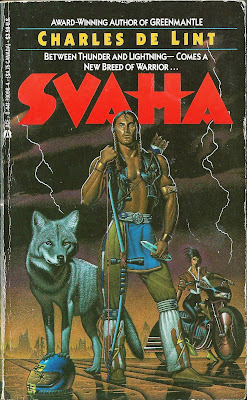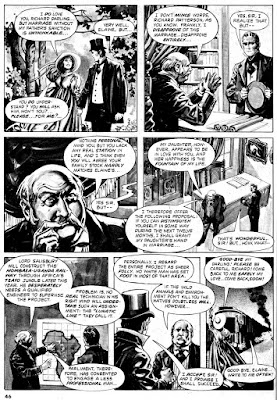3 / 5 Stars
‘Svaha’ (276 pp) was published by Ace Books in January 1989; the cover art is by Joe Burleson.
At the time this book was published, prolific Canadian author de Lint (b. 1951) had established himself as a founder of what would come to be called the ‘Urban Fantasy’ genre.
During the 70s de Lint had written a considerable number of novels, short stories, and poems set in the so-called ‘Cerin Songweaver’ world, but starting in the 80s, he began to write fiction that often was set in modern-day Ontario and detailed the adventures of Canadians who willingly (or unwillingly) transported themselves into the fairy realms that exist alongside ‘our’ reality.
‘Svaha’ was an effort by de Lint to meld his urban fantasy themes with………….cyberpunk ?! Whether or not you agree with my review of his book, you must agree that he deserves credit for this imaginative pairing.
‘Svaha’ is set in a near-future US where the government has collapsed, and a large tract of the northeast is a wasteland of abandoned buildings pitted by regular downpours of acid rain, and occupied by feral cannibals.
‘Svaha’ (276 pp) was published by Ace Books in January 1989; the cover art is by Joe Burleson.
At the time this book was published, prolific Canadian author de Lint (b. 1951) had established himself as a founder of what would come to be called the ‘Urban Fantasy’ genre.
During the 70s de Lint had written a considerable number of novels, short stories, and poems set in the so-called ‘Cerin Songweaver’ world, but starting in the 80s, he began to write fiction that often was set in modern-day Ontario and detailed the adventures of Canadians who willingly (or unwillingly) transported themselves into the fairy realms that exist alongside ‘our’ reality.
‘Svaha’ was an effort by de Lint to meld his urban fantasy themes with………….cyberpunk ?! Whether or not you agree with my review of his book, you must agree that he deserves credit for this imaginative pairing.
‘Svaha’ is set in a near-future US where the government has collapsed, and a large tract of the northeast is a wasteland of abandoned buildings pitted by regular downpours of acid rain, and occupied by feral cannibals.
Trenton, also known as the Megaplex, is the capital of the region; outside its walls lie the ‘squats’, a ring of slums whose population eke out their lives perpetually hoping that some turn of good fortune will permit them to live within the Megaplex. Lording over all these realms are competing factions made up of Japanese yakuza, Chinese tongs, and Japanese corporations.
The American Indians live aloof from this dystopia; through a combination of both hi-tech and mystical fonts of knowledge, they reside in Indians-only Eco-Topias, referred to as Enclaves. Surrounded by impenetrable barriers, the Enclaves preserve and celebrate Indian culture and tend to Mother Earth, while looking upon the tribulations of the Palefaces with indifference……….. and a certain degree of smugness.
As ‘Svaha’ opens an Enclave aircraft has crashed somewhere in the wastelands, and the craft’s computer chip – if it successfully can be decoded – promises to grant the user a complete knowledge of Enclave technology. The tongs, triads, yakuza, corporations, bandits, and raiders of the Megaplex and the squats all are vying to find the chip and make its secrets their own.
The Iroquois Enclave near Toronto has dispatched a warrior named Gahzee Animiki-Waewidum to recover the chip. It’s a one-way mission; Gahzee can never return to the Enclave, but he is dedicated to the cause of the People (as the Indians refer to themselves) and willing to die if need be.
The remainder of ‘Svaha’ details Gahzee’s efforts to traverse the wasteland and its dangers, and finding who holds the chip. So doing will require alliances with the more untrustworthy inhabitants of the squats. But Gazhee is not without formidable resources of his own, for he can access the separate reality known as the Dreamtime, where the gods of Indian myth and legend not only are real, but willing to bestow unique powers upon those they favor………..
I finished ‘Svaha’ thinking that it would have been a better novel had the ‘Injun Mysticism’ component been greatly reduced.
The cyberpunk segments of the novel will be immediately familiar to anyone who has read the early work of Gibson, Sterling, Kadrey, and Shirley: prose that is dense, highly descriptive, and filled with italicized idioms and phrases in Japanese (Nihongo). These segments propel the narrative and culminate in a denouement that stays true to the plot.
But the steady diet of segments devoted to Injun Mysticism are difficult to digest, and tend to sap the narrative of momentum. For example, author de Lint’s desire to lend his novel an authentic ‘Iroquois’ flavor means that within the book’s first few pages, the reader will have to negotiate a lumbering lexicon containing words like these: Mino-dae aeshowishinaug; Kikinowautchi-beedaudae; madjimadzuin; and Tci manaudjimikooyaun n’d’aupinumoon.
Too often the Injun segments come across as a too-earnest effort to pay ideological tribute to the wonder and majesty of the Amerindian Experience, ultimately serving to render the hero Gahzee as a kind of Redskin version of Jesus........?!
The verdict ? I can’t recommend ‘Svaha’ as a title worthy of being included in the cyberpunk canon, but its offbeat nature makes it attractive to those fans of the genre who are willing to plow through the Injun segments in order to get at the underlying cyberpunk goodness.
The American Indians live aloof from this dystopia; through a combination of both hi-tech and mystical fonts of knowledge, they reside in Indians-only Eco-Topias, referred to as Enclaves. Surrounded by impenetrable barriers, the Enclaves preserve and celebrate Indian culture and tend to Mother Earth, while looking upon the tribulations of the Palefaces with indifference……….. and a certain degree of smugness.
As ‘Svaha’ opens an Enclave aircraft has crashed somewhere in the wastelands, and the craft’s computer chip – if it successfully can be decoded – promises to grant the user a complete knowledge of Enclave technology. The tongs, triads, yakuza, corporations, bandits, and raiders of the Megaplex and the squats all are vying to find the chip and make its secrets their own.
The Iroquois Enclave near Toronto has dispatched a warrior named Gahzee Animiki-Waewidum to recover the chip. It’s a one-way mission; Gahzee can never return to the Enclave, but he is dedicated to the cause of the People (as the Indians refer to themselves) and willing to die if need be.
The remainder of ‘Svaha’ details Gahzee’s efforts to traverse the wasteland and its dangers, and finding who holds the chip. So doing will require alliances with the more untrustworthy inhabitants of the squats. But Gazhee is not without formidable resources of his own, for he can access the separate reality known as the Dreamtime, where the gods of Indian myth and legend not only are real, but willing to bestow unique powers upon those they favor………..
I finished ‘Svaha’ thinking that it would have been a better novel had the ‘Injun Mysticism’ component been greatly reduced.
The cyberpunk segments of the novel will be immediately familiar to anyone who has read the early work of Gibson, Sterling, Kadrey, and Shirley: prose that is dense, highly descriptive, and filled with italicized idioms and phrases in Japanese (Nihongo). These segments propel the narrative and culminate in a denouement that stays true to the plot.
But the steady diet of segments devoted to Injun Mysticism are difficult to digest, and tend to sap the narrative of momentum. For example, author de Lint’s desire to lend his novel an authentic ‘Iroquois’ flavor means that within the book’s first few pages, the reader will have to negotiate a lumbering lexicon containing words like these: Mino-dae aeshowishinaug; Kikinowautchi-beedaudae; madjimadzuin; and Tci manaudjimikooyaun n’d’aupinumoon.
Too often the Injun segments come across as a too-earnest effort to pay ideological tribute to the wonder and majesty of the Amerindian Experience, ultimately serving to render the hero Gahzee as a kind of Redskin version of Jesus........?!
The verdict ? I can’t recommend ‘Svaha’ as a title worthy of being included in the cyberpunk canon, but its offbeat nature makes it attractive to those fans of the genre who are willing to plow through the Injun segments in order to get at the underlying cyberpunk goodness.

















































































